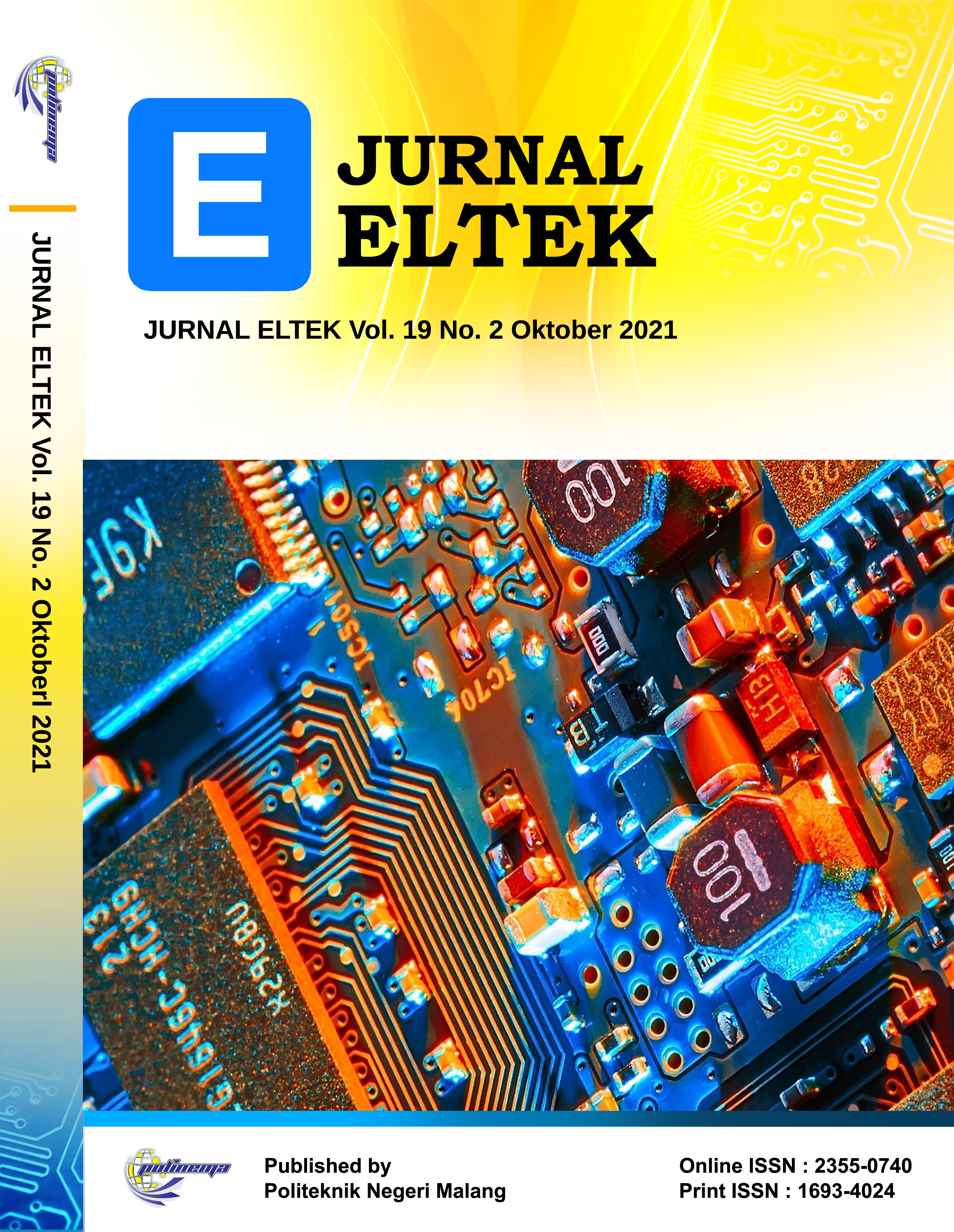Kajian PLTS on-grid pada gedung X Politeknik Negeri Malang untuk melayani beban perkantoran menggunakan perangkat HOMER PRO
DOI:
https://doi.org/10.33795/eltek.v19i2.320Keywords:
On Grid, HOMER PRO, Net Present Cost, Renewable FractionAbstract
Pembangkit Listrik Tenaga Surya (PLTS) dapat diaplikasikan mulai skala kecil sampai skala besar, itu merupakan keunggulan teknologi ini. Dalam skala kecil, pemanfaatan energi surya dapat diaplikasikan di setiap atap rumah untuk memenuhi kebutuhan listrik tiap konsumen residential / rumah tangga. Untuk kebutuhan ini, sistem PLTS dilakukan secara on – grid yaitu terhubung dengan jaringan yang sudah tersedia yaitu jaringan penyedia layanan listrik seperti PLN. Pada penelitian ini, objek penelitian adalah Gedung X pada Politeknik Negeri Malang, dimana kebutuhan bebannya sebesar 12,5 kW dan kebutuhan energi harian 64 kWh. Menggunakan aplikasi HOMER PRO didapatkan untuk sistem dengan skema PV, Baterai, Grid PLN, dan konverter, maka Skematik yang diusulkan pada sistem PLTS adalah menggunakan solar panel dengan total daya terpasang sebesar 11 kWp, dan ditambah dengan baterai sebesar 1500 Ah, konverter daya sebesar 6 kW , dan grid PLN tetap sebagai suplai utama. Untuk bisa mengurangi tagihan listrik, dilakukanlah Renewable Fraction (RF) sebesar 58,5 %, sehingga didapatkan produksi harian untuk solar panel sebesar 45,6 kWh, yaitu sebesar 68 % kebutuhan harian dengan capacity factor sebesar 17,3 %. Solar panel yang digunakan merk ICASOLAR dengan kapasitas 250 Wp membutuhkan sebanyak 44 panel dengan total luasan yang diperlukan sebesar 57 m2 pada atap gedung. Secara ekonomis didapatkan bahwa Net Present Cost pada sistem ini adalah sebesar Rp. 183.000.000,- dan nilai Cost of Energy sebesar Rp. 484,58,- / kWh
ABSTRACT
PLTS can be applied from small to large scale, that is the advantage of this technology. On a small scale, the use of solar energy can be applied on every roof of the house to meet the electricity needs of each residential / household consumer. For this need, the PLTS system is carried out on an on-grid basis, which is connected to an already available network, namely a network of electricity service providers such as PLN. In this study, the object of research is Building X at the State Polytechnic of Malang, where the load requirement is 12.5 kW and the daily energy requirement is 64 kWh. Using the HOMER PRO application obtained for systems with PV schemes, Batteries, PLN Grids, and converters, the proposed Schematic for the PLTS system is to use solar panels with a total installed power of 11 kWp, and coupled with a 1500 Ah battery, a power converter of 6 kW , and the PLN grid remains as the main supply. To be able to reduce electricity bills, Renewable Fraction (RF) is carried out by 58.5%, so that the daily production for solar panels is 45.6 kWh, which is 68% of daily needs with a capacity factor of 17.3%. The solar panels used by the ICASOLAR brand with a capacity of 250 Wp require 44 panels with a total required area of 57 m2 on the roof of the building. Economically, it is found that the Net Present Cost in this system is Rp. 183,000,000,- and Cost of Energy amount Rp. 484,58,- / kWh
References
Y. H. Abram Wawi Putra , Egia Kamandika,Sahilaushafnur, Agus Purwadi, “Study and Design ofHybrid Off-Grid PV-Generator Power System for Administration Load and Communal Load at ThreeRegions in Indonesia,”3rd IEEE Conf. Power Eng.Renew. Energy ICEPERE 2016, vol. 29B1-5, pp. 1–6,2016.
A. Purwadi, Y. Haroen, and N. Heryana, “Study of HybridPV-Diesel Power Generation System at Sebira Island-Kepulauan Seribu,” no. July, pp. 1–7, 2012. ESDM,Statistika Ketenagalistikan 2016. 2017.
H. Pro, “NASA Surface Meteorology and Solar EnergyDatabase,”homer Pro. 2018.
B. INDONESIA, “Data BI Rate,”Bank Sentral RepublikIndonesia, 2018. [Online]. National Energy Council, "Indonesia Energy Outlook 2016," Jakarta,2016.
E. A. M. G. S. A. A. E. Y. M. G. Magdy, "Microgrid dynamic securityconsidering high penetration of renewable energy,"Protection andControl of Modern Power Systems,vol. 23, no. 3, 2018.
S. R. S. S. S. A. K. S. A. Sumon Rashid, "Optimized design of a hybrid PV‐wind‐diesel energy system for sustainable development at coastalareas in Bangladesh,"Environmental Progress & Sustainable Energy,vol. 36, no. 1, pp. 297-304, 2017.
S. F. Hutapea and Agus Purwadi, “Design of hybrid PV-generator-battery system for two kind of loads at Aha village, Morotai Island,Maluku,” 2017 International Conference on Control, Electronics,Renewable Energy and Communication (ICCREC) pp. 127-131,December 2017.
D. M. Yuliawan, A. Purwadi, A. Rizqiawan, T. Akmal, and M. G. F Aqdomani, “Study and design of hybrid PV-generator-wind systemfor communal and administrative load in North Maluku, Indonesia.”,2018 IEEE Conference on Power Engineering and Renewable Energy (ICPERE), June 2019.
D. Schumacher, O. Belk, and A. Emadi, “Standalone integratedpower electronics system, application for off grid rural location,”IEEE Electrification Magazine, vol. 6, issue 4, pp. 73-82, December2018.
Noor Hussain Al Dulaimi, “Design of an Off – Grid Solar PV System for a Rural Shelter” School of Natural Resources Engineering and Management, Amman, Jordania, 2017
Arina Makarova, “ Study Design and Performance Analysis of a Grid – Connected Photovoltaic System”, Helsinki Metropolia University of Applied Science, 2017 Anonymous, “ Link Budget Design for RF Line – of – sight via Theoretical Propagation Prediction”,2019
L. Hakim, B.E.Prasetya, M.Fahmi, C.Wiharya, “ANALISIS PHOTOVOLTAIC DISTRIBUTED GENERATION (PVDG) PADA SISTEM DISTRIBUSI 20 KV GI SENGKALING PENYULANG PUJON UNTUK PERBAIKAN PROFIL TEGANGAN” 2020 Seminar Nasional Teknologi Elektro Terapan (SNTET) pp. 92-98, Agustus 2020.
Downloads
Published
How to Cite
Issue
Section
License
Copyright (c) 2021 Priya Surya Harijanto, Mochammad Junus

This work is licensed under a Creative Commons Attribution-ShareAlike 4.0 International License.







